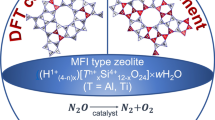Abstract
H, Li, Na, Cs, NH4, Mg and Al-ZSM 5 zeolites and H and NH4-mordenites were studied by DTA, X-ray diffraction, TPD and adsorption measurements. The stability relating to dealumination and structure destruction depends on the nature of the cation.
H and NH4-ZSM 5 were strongly dealuminated to silicalitelike phases in the temperature range 973–1273 K during the course of the DTA measurement. NH4-mordenite was dealuminated below 873 K in the TPD experiment on the deammonization.
The thermal destruction of ZSM 5 containing Na+, Mg2+, Al3+ and Cs+ ions begins at about 1400 K. Excess sodium ions present in the original Na-ZSM 5 decreased the thermal stability. For H and NH4-mordenites, complete amorphization was found at 1270 K.
Zusammenfassung
H-, Li-, Na-, Cs-, NH4-, Mg- und Al-Zeolithe ZSM 5 sowie H- und NH4-Mordenit wurden durch DTA, Röntgenbeugung, temperaturprogrammierte Desorption (TPD) und Adsorptionsmessungen untersucht. Die Stabilität gegenüber Dealuminierung und Strukturzusammenbruch hängt von der Art des Kations ab. H- und NH4-ZSM 5 werden im Verlauf der DTA-Messungen im Bereich 973–1273 K zu Silicalit-ähnlichen Phasen dealuminiert. NH4-Mordenit wird unterhalb 873 K bei der Ammoniakabspaltung im TPD-Experiment dealuminiert. Der thermische Zusammenbruch von Na-, Mg-, Al- und Cs-ZSM 5 beginnt um 1400 K. Im ursprünglichen NaZSM 5 vorhandene überschüssige Natriumionen verringern seine thermische Stabilität. Für H- und NH4-Mordenit wird bei 1270 K vollständige Amorphisierung gefunden.
Резюме
Методами ДТА,. рентген офазового анализа и адсорбции изучены H, Li, Na, Cs, NH4, Mg, Al ZSM 5 цеолиты и Н-, NН4-морден иты. Устойчивость к деалюминированнию и характер деструкции зависят о т типа катиона. Методо м ДТА установлено, что обра зцы Н- и NH4-ZSM 5 в интервале температ ур 973–1273 подвергаются интенсивному деалюм инированию с образов анием силикатоподобных фа з. При проведении ТПД экспериментов устан овлено, что NH4морденит деалюминируется ниж е температуры 873 К. Терм ическая деструкция образцов ZSM 5 цеолитов, содержащих коны натрия, цезия, маг ния и алюминия, начинается при температуре около 1400 К. Наличие избы точных ионов натрия в исходном образце цеолита NaZSM 5 уменьшает его термоу стойчивость. Полная а морфизация Н/NН4-морденита происхо дит при 1270 К.
Similar content being viewed by others
References
E. Alsdorf, M. Feist, H. Fichtner-Schmittler, Th. Gross, H.-J. Jerschkewitz, U. Lohse and B. Parlitz, Adsorption Science and Technology, submitted.
Pingdong Wu and Yi Hua Ma, 6th International Zeolite Conference, Reno 1983.
N. Topsoe, K. Petersen and E. Derouane, J. Catal., 70 (1981) 41.
M. Derewinski, J. Haber, J. Ptaszynski, J. A. Lerscher and G. Rumplmayr, Proceedings of the 7th International Zeolite Conference (ed. by Murakami et al.) Tokyo 1986, 957.
D. Kalló, I. Bankós and J. Papp, Proceedings International Symposium on Zeolite Catalysis, Siófok, Hungary 1985, 329.
Author information
Authors and Affiliations
Rights and permissions
About this article
Cite this article
Alsdorf, E., Feist, M., Fichtner-Schmittler, H. et al. Methods for characterization and their influence on the structure of silicon-rich zeolites. Journal of Thermal Analysis 33, 691–698 (1988). https://doi.org/10.1007/BF02138575
Issue Date:
DOI: https://doi.org/10.1007/BF02138575




